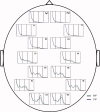Network analysis of resting state EEG in the developing young brain: structure comes with maturation
- PMID: 20589941
- PMCID: PMC6870229
- DOI: 10.1002/hbm.21030
Network analysis of resting state EEG in the developing young brain: structure comes with maturation
Abstract
During childhood, brain structure and function changes substantially. Recently, graph theory has been introduced to model connectivity in the brain. Small-world networks, such as the brain, combine optimal properties of both ordered and random networks, i.e., high clustering and short path lengths. We used graph theoretical concepts to examine changes in functional brain networks during normal development in young children. Resting-state eyes-closed electroencephalography (EEG) was recorded (14 channels) from 227 children twice at 5 and 7 years of age. Synchronization likelihood (SL) was calculated in three different frequency bands and between each pair of electrodes to obtain SL-weighted graphs. Mean normalized clustering index, average path length and weight dispersion were calculated to characterize network organization. Repeated measures analysis of variance tested for time and gender effects. For all frequency bands mean SL decreased from 5 to 7 years. Clustering coefficient increased in the alpha band. Path length increased in all frequency bands. Mean normalized weight dispersion decreased in beta band. Girls showed higher synchronization for all frequency bands and a higher mean clustering in alpha and beta bands. The overall decrease in functional connectivity (SL) might reflect pruning of unused synapses and preservation of strong connections resulting in more cost-effective networks. Accordingly, we found increases in average clustering and path length and decreased weight dispersion indicating that normal brain maturation is characterized by a shift from random to more organized small-world functional networks. This developmental process is influenced by gender differences early in development.
Copyright © 2010 Wiley-Liss, Inc.
Figures






Similar articles
-
The influence of ageing on complex brain networks: a graph theoretical analysis.Hum Brain Mapp. 2009 Jan;30(1):200-8. doi: 10.1002/hbm.20492. Hum Brain Mapp. 2009. PMID: 17990300 Free PMC article.
-
Functional neural network analysis in frontotemporal dementia and Alzheimer's disease using EEG and graph theory.BMC Neurosci. 2009 Aug 21;10:101. doi: 10.1186/1471-2202-10-101. BMC Neurosci. 2009. PMID: 19698093 Free PMC article.
-
Heritability of "small-world" networks in the brain: a graph theoretical analysis of resting-state EEG functional connectivity.Hum Brain Mapp. 2008 Dec;29(12):1368-78. doi: 10.1002/hbm.20468. Hum Brain Mapp. 2008. PMID: 18064590 Free PMC article.
-
The utility of EEG band power analysis in the study of infancy and early childhood.Dev Neuropsychol. 2012;37(3):253-73. doi: 10.1080/87565641.2011.614663. Dev Neuropsychol. 2012. PMID: 22545661 Free PMC article. Review.
-
The development of human functional brain networks.Neuron. 2010 Sep 9;67(5):735-48. doi: 10.1016/j.neuron.2010.08.017. Neuron. 2010. PMID: 20826306 Free PMC article. Review.
Cited by
-
EEG functional connectivity is partially predicted by underlying white matter connectivity.Neuroimage. 2015 Mar;108:23-33. doi: 10.1016/j.neuroimage.2014.12.033. Epub 2014 Dec 19. Neuroimage. 2015. PMID: 25534110 Free PMC article.
-
Altered cortical structure network in children with obstructive sleep apnea.Sleep. 2022 May 12;45(5):zsac030. doi: 10.1093/sleep/zsac030. Epub 2022 Feb 5. Sleep. 2022. PMID: 35554588 Free PMC article.
-
Reduced Theta Connectivity during Set-Shifting in Children with Autism.Front Hum Neurosci. 2013 Nov 14;7:785. doi: 10.3389/fnhum.2013.00785. eCollection 2013. Front Hum Neurosci. 2013. PMID: 24294201 Free PMC article.
-
Your Brain on Art: Emergent Cortical Dynamics During Aesthetic Experiences.Front Hum Neurosci. 2015 Nov 18;9:626. doi: 10.3389/fnhum.2015.00626. eCollection 2015. Front Hum Neurosci. 2015. PMID: 26635579 Free PMC article.
-
The maturation of cortical sleep rhythms and networks over early development.Clin Neurophysiol. 2014 Jul;125(7):1360-70. doi: 10.1016/j.clinph.2013.11.028. Epub 2013 Dec 6. Clin Neurophysiol. 2014. PMID: 24418219 Free PMC article.
References
-
- Barry RJ, Clarke AR, McCarthy R, Selikowitz M, Johnstone SJ, Rushby JA ( 2004): Age and gender effects in EEG coherence. I. Developmental trends in normal children. Clin Neurophysiol 115: 2252–2258. - PubMed
-
- Bell MA, Fox NA ( 1996): Crawling experience is related to changes in cortical organization during infancy: Evidence from EEG coherence. Dev Psychobiol 29: 551–561. - PubMed
-
- Boomsma DI, Orlebeke JF, van Baal GC ( 1992): The Dutch Twin Register: Growth data on weight and height. Behav Genet 22: 247–251. - PubMed
-
- Boomsma DI, van Baal GC ( 1998): Genetic influences on childhood IQ in 5‐ and 7‐year‐old Dutch twins. Developmental Neuropsychology 14: 115–126.
Publication types
MeSH terms
LinkOut - more resources
Full Text Sources

